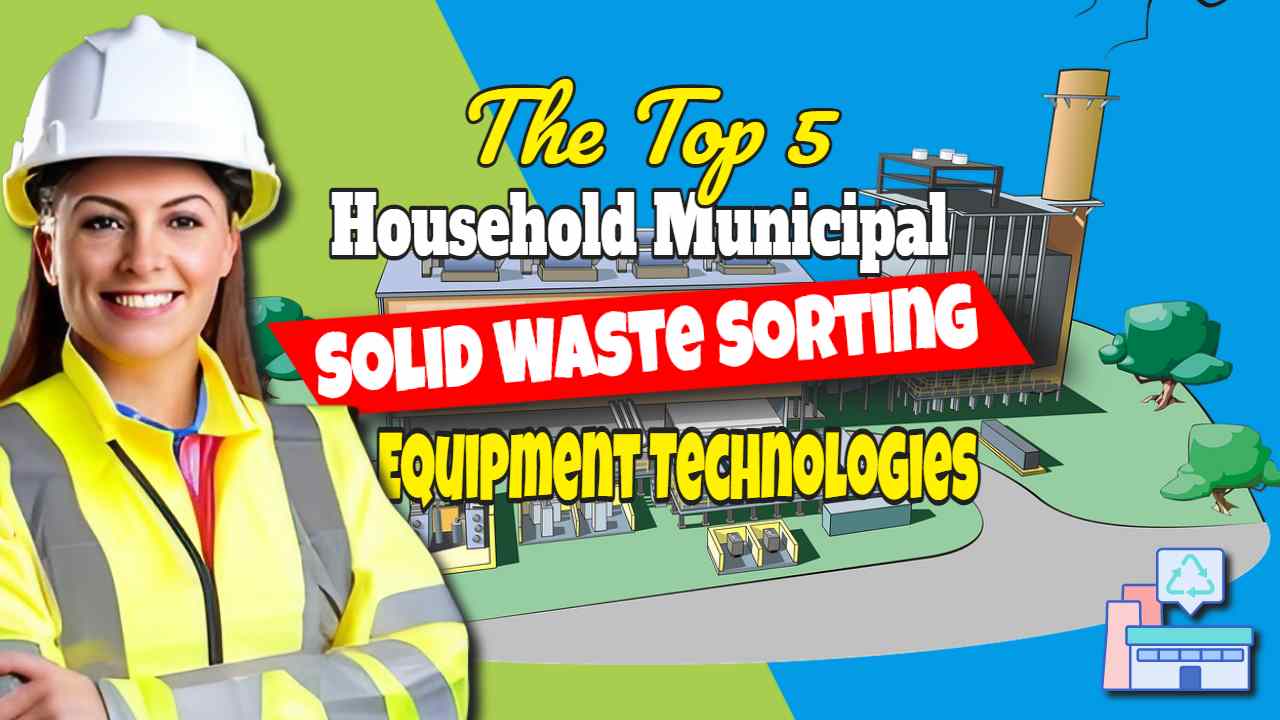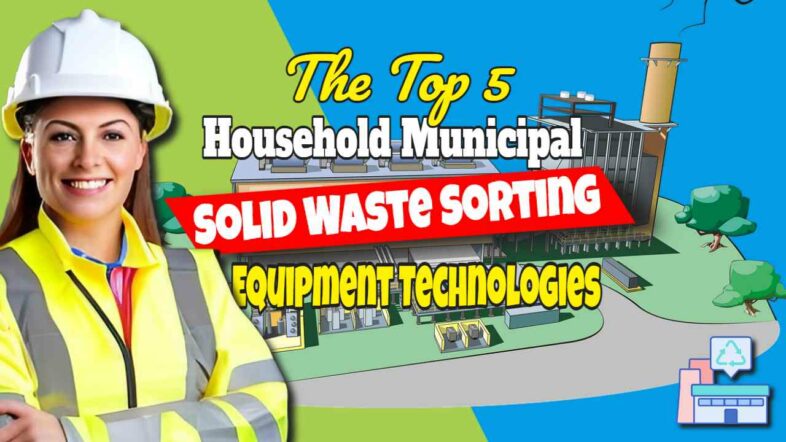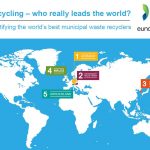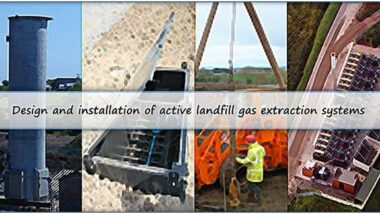It is important that our readers know about the 6 top household Municipal Solid Waste sorting equipment technologies as more and more waste is diverted away from landfills for recycling, and a more sustainable circular economy grows.
That's because the proper management of household municipal solid waste (MSW) is crucial for both environmental and public health reasons. One key aspect of this management is sorting, which separates recyclable materials from non-recyclable waste.
In recent years, advances in technology have led to the development of new and improved sorting equipment.
In this article, we will discuss the six top household MSW sorting equipment technologies currently in use which are:
- screening,
- magnetic separation,
- eddy current separation,
- air classification, and
- optical sorting.
Each of these technologies has its own unique advantages and disadvantages, and we will explore them in detail to help readers understand the best options for their specific needs.
Whether you represent a municipality looking to improve your waste management operations or an individual looking to recycle more effectively, this article will provide valuable information.
1 – Screening
Screening in drum screens was the primary separation process for municipal solid waste processing until recently. There are now alternatives such as vibrating tables, but in this article we will focus on drum screens, also known as trommels.
Drum screens are primarily used for pre-classification in sizes ranging from 100 mm to 300 mm. Selectivity can be achieved with separation sizes ranging from 200 mm to 240 mm. Material with a high calorific value is concentrated in the coarse fraction. Separation occurs between 80 mm and 25 mm in the fine particle range. The separating grain size is determined by the further utilisation of the fine fraction. While the fine fraction for composting should be relatively coarse, it must be 40 mm for dry fermentation processes.
Clogging and wrapping protection in drum screens
The use of drum screens for coarse screening causes significant problems with screening media plugging. Within a few hours, the open screening surface area (A0) can be reduced to the point where significant changes in mass flows occur.
According to Ref: 1 various analyses have revealed that up to 50% of the open screening area can be plugged during a single eight-hour shift. An appropriate measure against plugging is to use tube constructions which are welded from the outside onto the screen openings.
Although screening is very important in processing technology – some plants do not have any further processing stages – this technique is not given enough attention. Only a few delivery specifications include screening efficiency requirements. This efficiency is frequently only 70 to 80% in plants, despite the fact that an efficiency of >95% is possible. As a result, fine material is discharged through the screen overflow, which has a negative impact on product quality. The same effect occurs when MSW, which is extremely difficult to screen due to a strong tendency to hook together, is screened at 100 mm sizes without a coarse pre-screening stage. Given the importance of the screening step in the overall preparation process, a view on the size distribution of municipal waste is extremely useful.
Both the screen underflow and overflow products from mixed MSW have a completely different composition; the first enrich the organic components, while the coarse fraction contains the majority of the highly calorific particles.
Screening is used to separate two fractions of waste by size. It produces 2 waste streams known as the overflow and the underflow.
True MSW sorting begins on the overflow only after the screening stage has removed the smaller fraction which drops through the mesh of the screen.
This is often called the organic fraction of MSW due to the preponderance of organic material within this fraction.

Sorting Municipal Solid Waste
In mechanical processing plants for the treatment of municipal solid waste, the following sorting technologies are routinely used:
- Magnetic separation
- Eddy current separation
- Air classification
- Optical sorting
2 – Magnetic separation
Ferromagnetic materials in MSW, such as tin cans, are typically separated very effectively using suspended magnetic belt separators. Aside from tin plate, the feed mixture contains a wide range of irregularly shaped components with large surface areas, such as plastic films.
This results in heavily polluted scrap products. Magnetic separators with alternating pole systems have a much higher separation efficiency. Nonetheless, due to cost considerations, these technologies are only used infrequently.
A high-efficiency separation of ferrous metals is required for the fine fraction of municipal solid waste to be treated biologically. In many cases, a 95% recovery is not possible due to the difficult material conditions. Furthermore, the feed material contains a large number of compound materials, such as batteries, that cannot be separated using conventional magnetic fields.
In this case, the use of permanent magnetic neodymium drum separators yields positive results. They use high field gradients to separate even small batteries, videotapes, and ball pen cartridges with high efficiency.
Thereby, the application of such magnetic separators has a veritably positive effect regarding the final content of heavy metals in the material to be treated biologically.
However, when using this method to separate a magnetic product, the use and recycling of the ferrous product must be clarified. The product is contaminated with small non-magnetic particles and wet organic ingredients because the strong field attracts weakly magnetic items.
As a result, in order to clean the magnetic product, another sorting step is usually required.
3 – Eddy current separation
In recent years, there has been a lot of progress in the field of nonferrous metal separation by eddy currents. Today, eddy current separators with eccentrically arranged pole wheels in the head pulley and modern high-intensity permanent magnets based on neodymium-iron-boron are preferred.
Because of the number of pole pairs and the high frequency of the alternating magnetic field (up to 1000 cps), non-ferrous metals can be separated from waste material mixtures with grain sizes as small as 1 mm. Items fed into an eddy current separator must be separated from one another because the separation requires a single-grain layer on the belt to avoid cross-contamination. As a result, it is critical for particle isolation that a preceding screen sizing and feeding with a vibrating conveyor take place.
The most common nonferrous metal found in MSW is aluminium, which can be found in cans, various packaging items, or bottle caps, for example. The Al-yield can reach 90%, and the grade of the NF-product is heavily influenced by the waste mixture and pretreatment.
Because aluminium is frequently used in combination with other materials, such as beverage cartons or toothpaste tubes, a content of 60% – 70% aluminium-based particles can be achieved. As a result, the aluminium content of the product is typically low.
As a result, further processing of this product, such as pyrolysis, is required.
4 – Air classification
Air classification is a simple technology for efficiently sorting airborne constituents from waste mixtures. The fact that a certain amount of household waste components with a high calorific value, such as paper or plastics, primarily occur in the form of foils is taken into account here.
This shape criterion is far more important than density in this sorting process. Aside from shape and density, the structure of the various material groups is also important for air classification.
Textiles, for example, are particularly absorbent of humidity within collection containers, resulting in a high density when compared to plastic foils.
While zig-zag air classifiers were commonly used in the early days of MSW processing, the cross-flow air classifier shown in the figure is now the most important sorting installation. Cross-flow air classifiers work with partially recirculated air.
The amount of fresh air increased by 30%. A very high-quality fuel, consisting primarily of plastic foils, thin body-type plastics, and dry paper, can be concentrated using a blower and sucker construction.
The light material yield is at least 70%. The density of the load, which should not exceed 350 g/m3 of air per hour, is a limiting factor. 10-15% of RDF with a high calorific value can be concentrated from typical household waste.
When using air classifiers for larger particle sizes (>240 mm), there is a high potential for disturbances in the pneumatic transport of the light fraction. Furthermore, because the profile of the air separation chamber is limited, plugging caused by very large single particles cannot be avoided. In this case, simple blower constructions that eject air into the material flow from above have proven to be useful. This “extends” the flight trajectory of the light material components while having no effect on heavier or body-shaped particles.
5 – Technologies for optical sorting
For more than 20 years, optical sorting with automated picking has been used in the colour separation of cullet. The transmission measurement was used as a detection system. Many developers have been looking for new detection techniques in recent years. Image detection and near-infrared (NIR) detection are particularly noteworthy. These techniques can only be realised now that powerful computers that can handle large amounts of data very quickly are available.
NIR-sorting systems can be used to separate components with a high calorific value, such as plastics, paper, cardboard, diapers, wood, and beverage cartons. The isolated waste particles are transported at up to 2.5 m/s via a belt conveyor beneath a light source.
The NIR spectrum of the particles is identified by a detector. If, for example, a desired type of plastic is identified, the process computer sends a signal to an air nozzle system located at the transport belt's end.
The particle or item is blown out of the flight trajectory and discharged separately with a short air blast.
Automated picking technology
The detection system and air nozzles divide the belt cross-section into elements with a width of about 10 mm, allowing for particle sorting across a wide size range.
The detection rate is greater than 10.000 per second. The time required to toggle single nozzles is approximately 10 ms, resulting in a powerful technology that allows throughputs of 8 to 10 tonnes per hour with a machine width of 2.000 mm. Figure 2 depicts the basic operation of an automated picking system with NIR detection.
Figure 2 is a diagram. NIR-automatic picking device principle
New technologies – positive experiences
Over the last few years, the use of optical sorting for the processing of packaging waste material has resulted in very positive experiences with these new technologies. Today, the spectra of many types of plastics are programmed to include various disturbances caused by pollutants such as dirt or water.
Single types of plastics can also be separated selectively using optical sorting machines.
This enables, for example, negative sorting of PVC, influencing the parameter of chlorine concentration, which is a key parameter specified for RDF compliance for boiler use. Aside from sorting plastics with a yield of more than 80%, NIR can detect cellulose such as wood, paper, cotton, or cellulose from diapers.
However, due to stronger disturbances, the yield is much lower, ranging from 50 to 60%.
Combination of NIR detection with image analysis
Detecting single particles using NIR alone is not always sufficient. Recent advancements have enabled the combination of NIR detection with image analysis using highly sophisticated cameras.
Sorting machinery with these features can separate particles with very specific characteristics, such as differences in the type of colour or printer used for the surface design.
When comparing traditional separating technologies that use different material conditions such as shape or density to the “new” technology of automated picking, one major difference must be noted.
Separation according to the quality of the product
Separation according to the specific quality of each product found in waste mixtures is possible with automated picking technology. These self-learning AI systems can evaluate typical parameters for various detection tasks.
The “old” technologies, on the other hand, are divided into one main attribute and some additional or overlapping attributes. As a result, both the efficiency of separating processes such as air separation and vibration separation, as well as the quality of sorting products, are limited.
If a technology that separates based on hardness or flexibility is used, a flexible PVC particle will be discharged in the “light” product, while a hard PVC tube will enter the “heavy” product.
As a result of the preparation process, PVC selectivity is limited. As a result of the introduction of automated picking processes in the rough field of operating municipal waste, waste processing has reached a new level of quality.
CONCLUSIONS
Today, it is possible to process household waste with high efficiency. Modern magnetic and eddy-current separators, as well as optical sorting systems, can be used to recycle a variety of materials for the production of high-quality recycled products.
Aside from metals, the production of a high calorific value fraction (RDF) is of interest, and much improved plastic resin recycling is possible.
A high yield and good quality can be obtained by using modern processing technology to produce such RDF fractions.
Reference:
Proceedings Sardinia 2003, Ninth International Waste Management and Landfill Symposium, Margherita di Pula, Cagliari, Italy; 6 – 10 October 2003. 2003 by CISA, Environmental Sanitary Engineering Centre, Italy
A Review of the Ebook “An Introduction to Landfill Gas Extraction Systems”
Welcome to this review for the ebook “An Introduction to Landfill Gas Extraction Systems”. This ebook is a comprehensive guide for anyone involved in landfill gas extraction design, installation, operation, and maintenance, as well as landfill gas energy from waste (EfW) projects. About the Author The author, Steve Last, provides over 50 pages of essential […]
How a Food Waste Separator Makes Disposing of Leftovers Easier
A food waste separator makes it easy to dispose of leftovers and scraps of food. This machine is usually equipped with an auger that pushes the waste into the separator unit itself. Various shaped paddles and rods in the separator press the food waste through screens. The separated material drops out as a slurry, with […]
Reuse Old Materials by Applying These Furniture Recycling Ideas
When the time comes to replace your kitchen, why not reuse (repurpose) old materials by applying these furniture recycling ideas/ tips? It's tempting to just throw the existing cabinets away and start from scratch. That's not only unnecessary, it's wasteful. That's because the majority of kitchen cabinet materials are non-recyclable. This creates a significant problem […]
World Recycling Statistics – Top 5 List of Recycling Countries 2018
World recycling statistics supplied by governments vary in how they classify and record recycling rates, so we provide our Top 5 List of Recycling Countries 2018, as adjusted recycling rates to reveal the true top recycling nations. Additionally, recycling rates are also a delusion for a number of countries which after adjustment are shown to […]






